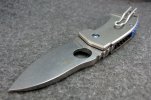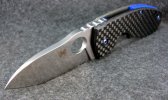-
The BladeForums.com 2024 Traditional Knife is ready to order! See this thread for details: https://www.bladeforums.com/threads/bladeforums-2024-traditional-knife.2003187/
Price is$300$250 ea (shipped within CONUS). If you live outside the US, I will contact you after your order for extra shipping charges.
Order here: https://www.bladeforums.com/help/2024-traditional/ - Order as many as you like, we have plenty.
You are using an out of date browser. It may not display this or other websites correctly.
You should upgrade or use an alternative browser.
You should upgrade or use an alternative browser.
Spyderco Tank of a Knife?
- Thread starter JDX
- Start date
- Joined
- Aug 2, 2015
- Messages
- 1,566
Another vote for Gayle Bradley 1. All I carry at work, anymore.
- Joined
- Oct 5, 2005
- Messages
- 2,400
I can personally attest that the Techno definitely qualifies:

Thick blade stock of a stainless, refined derivative of D2 tool steel. Thick titanium scales with G-10 backspacer. Best of all? It still slices like nothing, thanks to the flat grind and edge geometry.

Thick blade stock of a stainless, refined derivative of D2 tool steel. Thick titanium scales with G-10 backspacer. Best of all? It still slices like nothing, thanks to the flat grind and edge geometry.
Attachments
Milwaukee folding utility knife and a big box of blades.
Super steels are cool but carpet is a job for disposable blades.
Sent from my iPhone using Tapatalk
I prefer the very comfortable and ergonomic feel of the traditional $2 (now with inflation) straight handle utility knife with disposable razor blades. I think they have hooked ones for carpet. I see you're wearing gloves which reduces the need for registration in the grip, but the plain-jane (not the new funky styles) of box cutters have always served me better for carpet and cardboard.
Try and find an older Chinook or Manix.
I have a 1st Gen Chinook in 440V and the blade stock is probably the thickest in my collection of Spyderco's.
Hey Brother you hit that one out of the park for sure
Another great folder from the early 2000s decade is the C-46 Lum Tanto folder. That is a "brute" of a knife and I wouldn't get rid of either of the ones I still own. For the most part it seems like most of the really beefy Spyders are made at the GOLDEN, CO USA Earth plant.
- Joined
- Apr 15, 2012
- Messages
- 1,104
RE: your thread title.
My experiences would suggest Spyderco Ed Schempp TUFF C151GTi (a 3v blade in a folder designed with very secure lockup). Ergonomics are stellar in my mind (Ed Schempp design, hmmm .
.
RE: for your usage description.
It sounds like you spend some work time in a construction type environment. With over 30-yrs practical experience I would suggest Stanley 10-499 (similar to what others have posted previously). One has lived in my bags for numerous decades (always at least one spare too, along with multiple replacement blades in various configurations).
Takes about 2-seconds to change out a blade (fresh sharp blade OR different configuration entirely). Replacement blades are stored in the handle for quick-change as needed.
For carpet (as you referenced), as well as tough cutting roofing materials the various hook blades profiles really excell as they cut from the bottom side. For carpet - means cutting the backing easily from the topside with sharpened edge not being abused by embedded debris. For roofing with exposure faced embedded ceramic granuals - same principal as the carpet, but much more significant.
It would be hard for me to imagine using a cutting tool with a thick blade when there are purpose built tools for utility cutting tasks where a thin profile is so much more efficient.
Stanley 10-499 Open
http://i215.photobucket.com/albums/cc155/ChrisOBucket/Knives/Stanley 10-499-open.jpg
Stanley 10-499 Closed
http://i215.photobucket.com/albums/cc155/ChrisOBucket/Knives/Stanley 10-499-closed.jpg
Stanley 10-499 Blades Options are MANY (more than just tgese images.
http://i215.photobucket.com/albums/cc155/ChrisOBucket/Knives/Stanley 10-499 Blades.jpg
There are a number of handle configurations available (bent, straight, folder, flipper, etc.) with quick-change options and various blade profiles. For overall usage, I prefer the original straight handle but also have angled versions for use depending on application specifics (job at hand).
Hopefully some enlightenment here for someone ;-)
Regards,
My experiences would suggest Spyderco Ed Schempp TUFF C151GTi (a 3v blade in a folder designed with very secure lockup). Ergonomics are stellar in my mind (Ed Schempp design, hmmm
RE: for your usage description.
It sounds like you spend some work time in a construction type environment. With over 30-yrs practical experience I would suggest Stanley 10-499 (similar to what others have posted previously). One has lived in my bags for numerous decades (always at least one spare too, along with multiple replacement blades in various configurations).
Takes about 2-seconds to change out a blade (fresh sharp blade OR different configuration entirely). Replacement blades are stored in the handle for quick-change as needed.
For carpet (as you referenced), as well as tough cutting roofing materials the various hook blades profiles really excell as they cut from the bottom side. For carpet - means cutting the backing easily from the topside with sharpened edge not being abused by embedded debris. For roofing with exposure faced embedded ceramic granuals - same principal as the carpet, but much more significant.
It would be hard for me to imagine using a cutting tool with a thick blade when there are purpose built tools for utility cutting tasks where a thin profile is so much more efficient.
Stanley 10-499 Open
http://i215.photobucket.com/albums/cc155/ChrisOBucket/Knives/Stanley 10-499-open.jpg
Stanley 10-499 Closed
http://i215.photobucket.com/albums/cc155/ChrisOBucket/Knives/Stanley 10-499-closed.jpg
Stanley 10-499 Blades Options are MANY (more than just tgese images.
http://i215.photobucket.com/albums/cc155/ChrisOBucket/Knives/Stanley 10-499 Blades.jpg
There are a number of handle configurations available (bent, straight, folder, flipper, etc.) with quick-change options and various blade profiles. For overall usage, I prefer the original straight handle but also have angled versions for use depending on application specifics (job at hand).
Hopefully some enlightenment here for someone ;-)
Regards,



